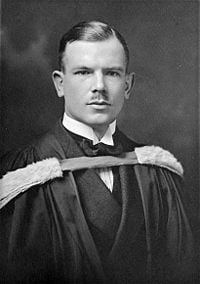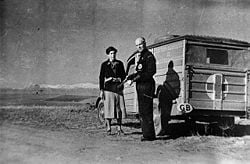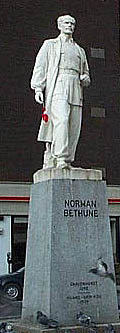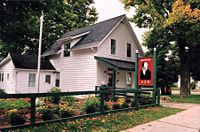Norman Bethune
Dr. Henry Norman Bethune, MD (March 3, 1890 – November 12, 1939) was a Canadian physician, medical innovator, and humanitarian. In Chinese, he is known as "Bai Qiuen" (白求恩).
Biography
The son of Christian missionaries, Dr. Bethune was born in Gravenhurst, Ontario, Canada. His grandfather, Norman Bethune was also a noted Canadian physician and founder of one of the first medical schools in Toronto.
After completing his medical studies at the University of Toronto (having also, mid-program, worked for a year as a labourer-teacher with Frontier College), Bethune moved to Montreal where he was associated with McGill University and taught thoracic surgery. Bethune was an early proponent of universal health care, the success of which he observed during a visit to the Soviet Union. As a doctor in Montreal, Bethune frequently sought out the poor and gave them free medical care. In 1915, he joined the the No.2 Field Ambulance Medical Corps in France, where, as a stretcher-bearer, he was hit by shrapnel and spent three months recovering in an English hospital.
As a thoracic surgeon, he travelled to Spain (1936-1937), aiding the Republicans in the Spanish Civil War and to China (1938-1939), aiding the Chinese in their war with Japan, in both cases performing battlefield surgical operations on war casualties.
Bethune's work in Spain in developing mobile medical units was the model for the later development of Mobile Army Surgical Hospital (MASH) units. The need to provide blood transfusions in a battlefield led him to develop the first practical method for transporting blood. In China, he worked with carpenters and blacksmiths to forge new surgical tools, and established training for doctors, nurses and orderlies. He redesigned packing containers to serve as operating tables.[1] He treated wounded Japanese prisoners.[2]
Bethune died on November 12, 1939, of blood poisoning from a cut he received when performing surgery, while with the Communist Party of China's Eighth Route Army in the midst of the second Sino-Japanese War.
Motivations
The Communist Party of Canada (CPC) asserts that Bethune, who joined the party in 1935, acted out of devotion to the Chinese socialist movement. Some in the West, however, have been highly skeptical to the notion and generally believe the doctor's motivation was exclusively based on humanitarian considerations. The fact remains that Bethune went to Spain soon after joining the Communist Party of Canada to help in the struggle against fascism, and then went to China to help the Communists there against Japanese imperialism. It is also noted in his most recent biography, The Politics of Passion, by Larry Hannant, that he specifically refused to work under Chiang Kai Shek's Nationalist government and insisted on helping the Chinese Communists instead. He is one of the few Westerners to have a statue in Communist China, and also has a hospital and a medical school named in his honour.
Memory
Virtually unknown in his homeland during his lifetime, Doctor Bethune finally received international recognition when Chairman Mao Zedong of the People's Republic of China published his essay entitled In Memory of Norman Bethune (in Chinese: 紀念白求恩), which documented the final months of the doctor's life in China. Mao made the essay required reading for the entire Chinese population. Mao concluded in that essay: We must all learn the spirit of absolute selflessness from him. With this spirit everyone can be very helpful to each other. A man's ability may be great or small, but if he has this spirit, he is already noble-minded and pure, a man of moral integrity and above vulgar interests, a man who is of value to the people.
Bethune University of Medical Sciences in Changchun, Bethune College at York University, and Dr Norman Bethune Collegiate Institute (a secondary school) in Scarborough, Ontario, were named after Dr. Bethune. Heroic statues of Bethune have been erected throughout China.
The Canadian government purchased his father's and his neighbour's house in Gravenhurst and restored the houses into the Bethune Memorial House in 1976. The house is a National Historic Site of Canada. In August 2002, then Governor General Adrienne Clarkson, who has Chinese ancestry, visited the house and unveiled a bronze statue of him.
Montreal created a public square and erected a statue in his honour, near Guy-Concordia metro station.
Bethune improved upon a number of surgical instruments. His most famous instrument was the "Bethune Rib Shears"[2].
Dr. Bethune (Chinese: 白求恩大夫), One of the most successful Chinese movies was made in 1964 in memory of him, in which Gerald Tannebaum (Traditional Chinese: 譚寧邦; Simplified Chinese: 谭宁邦; pinyin: Tán Níngbāng), an American humanitarian, played Bethune.
Donald Sutherland played Bethune in two biographical films: Bethune (1977), made for television on a low budget, and Bethune: The Making of a Hero (1990). The latter was a co-production of Telefilm Canada, the Canadian Broadcasting Corporation, FR3 TV France and China Film Co-production.
In March 1990, to commemorate the centenary of his birth, Canada and China each issued two postage stamps of the same design in his honour.
In 1998, he was inducted into the Canadian Medical Hall of Fame.
In the CBC's The Greatest Canadian program in 2004, he was voted the 26th Greatest Canadian by viewers. In 2006 China Central Television produced a 20-part drama series, Dr Norman Bethune, documenting his life, which with a budget of Yuan 30 million (US$3.75 million) was the most expensive Chinese TV series to date. [3]
He attended Owen Sound Collegiate in Owen Sound, Ontario, now known as Owen Sound Collegiate And Vocational Institute. He graduated from OSCVI in 1911 along with William Avery "Billy" Bishop. Both names are inscribed on the School's Great War Memorial.
He is buried in Shijiazhuang, Hebei Province, China, where his tomb along with that of Dr. Dwarkanath Kotnis lie next to great memorials and statues to their honour.
The 2006 novel The Communist's Daughter, by Dennis Bock, is a fictionalized account of Bethune's life.
The book of short stories, "Cottage Gothic," by Martin Avery, contains fictionalized accounts of Bethune's life, particularly in the story "Chinese Gold," which also appeared in Best Canadian Stories. Both books were published by Oberon Press.
Norman Bethune on "youtube": http://www.youtube.com/watch?v=RA2P59cSXAA
See also
- James Gareth Endicott
- Dwarkanath Kotnis
- Jakob Rosenfeld
ReferencesISBN links support NWE through referral fees
- ↑ [1] Alexander, C A, New York-tidewater chapters' history of military medicine award: The military odyssey of Norman Bethune, Military Medicine, Apr 1999
- ↑ Wounds, 1939
- ↑ Xinhua. Sixty-seven years on, Canadian idealist moves China again. People's Daily Online. Retrieved September 1, 2006.
External links
- Bethune page at Bethune Institute, with links to Bethune's writings.
- Wounds: if people could see the carnage of war they'd no doubt take the time to figure our who stands to benefit Norman Bethune, 1939. "The kerosene lamp overhead makes a steady buzzing sound like an incandescent hive of bees. Mud walls. Mud floor. Mud bed. White paper windows. Smell of blood and chloroform. Cold. Three o'clock in the morning, December 1, North China, near Lin Chu, with the 8th Route Army...."
- CBC Digital Archives - 'Comrade' Bethune: A Controversial Hero
- R Patterson, Norman Bethune: his contributions to medicine and to CMAJ. CMAJ. 1989 November 1; 141(9): 947–953. [full text]
- Famous Canadian Physicians: Dr. Norman Bethune at Library and Archives Canada
Credits
New World Encyclopedia writers and editors rewrote and completed the Wikipedia article in accordance with New World Encyclopedia standards. This article abides by terms of the Creative Commons CC-by-sa 3.0 License (CC-by-sa), which may be used and disseminated with proper attribution. Credit is due under the terms of this license that can reference both the New World Encyclopedia contributors and the selfless volunteer contributors of the Wikimedia Foundation. To cite this article click here for a list of acceptable citing formats.The history of earlier contributions by wikipedians is accessible to researchers here:
The history of this article since it was imported to New World Encyclopedia:
Note: Some restrictions may apply to use of individual images which are separately licensed.




